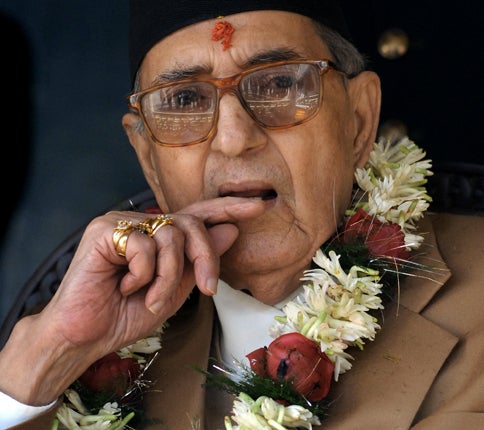Girija Koirala: Politician who led the drive for peace and democracy in Nepal

Your support helps us to tell the story
From reproductive rights to climate change to Big Tech, The Independent is on the ground when the story is developing. Whether it's investigating the financials of Elon Musk's pro-Trump PAC or producing our latest documentary, 'The A Word', which shines a light on the American women fighting for reproductive rights, we know how important it is to parse out the facts from the messaging.
At such a critical moment in US history, we need reporters on the ground. Your donation allows us to keep sending journalists to speak to both sides of the story.
The Independent is trusted by Americans across the entire political spectrum. And unlike many other quality news outlets, we choose not to lock Americans out of our reporting and analysis with paywalls. We believe quality journalism should be available to everyone, paid for by those who can afford it.
Your support makes all the difference.Girija Prasad Koirala was an integral part of Nepal's modern political history and served as its prime minister five times. He was a champion of democracy and architect of the peace talks with the Maoists which brought to an end a bloody 10-year insurgency that killed thousands; his efforts brought the rebels into the mainstream and paved the way for abolishing the 239-year-old Hindu monarchy.
The youngest of five sons and one daughter, he came from a political family – his father Krishna Prasad Koirala had defied the despotic Rana regime and Girija was born in exile in north-east India. He studied at Varanasi, initially seduced by Communist ideology but thereafter always advocating democracy.
Like his father, and brothers Matrika and Bishweshwar, both of whom would also serve as prime minister of Nepal, he participated in the freedom movement in India, spearheaded by his "role model" Mohandas Gandhi, as well as in the struggle against the Rana dynasty at home. In the late 1940s he led a workers' strike in Biratnagar, founded the Nepal Trade Union Congress and launched an insurrection against the Rana rule at the behest of the Nepali Congress (NC) party. Appointed Morang district president of the NC in 1952, he held the position until his arrest in the 1960 coup d'état by King Mahendra, who deposed Bishweshar as Prime Minister and began a 30-year reign of terror against pro-democratic elements and the NC.
Released in 1967, Girija went into self-imposed exile in India with Bishweshwar and others, working towards democracy in Nepal; he masterminded the hijacking of a Nepalese aircraft ferrying cash, printed fake Indian currencies and procured weapons. He became the NC's general secretary in 1975 and returned to Nepal in 1979 as part of the national reconciliation campaign.
Long seen as Bishweshwar's lieutenant, he came into his own after his brothers' death in 1982. The NC forged an alliance with leftist groups and organised a nationwide Civil Disobedience Movement. Mass participation and support from Indian leaders helped restore democracy in Nepal in 1990. In May 1991 Koirala followed in Bishweshwar's footsteps, becoming the country's second democratically-elected prime minister following the incumbent premier Krishna Prasad Bhattarai's defeat in Nepal's first nationwide multi-party elections.
He went on to serve as prime minister four more times; his third term (March 2000-July 2001) was marred by the bloodbath in which Crown Prince Dipendra shot and killed King Birendra and eight other members of the royal family before his own apparent suicide. Koirala resigned in the heat of growing Maoist insurgency and the military was mobilised in the civil war for the first time.
When the new, ambitious monarch King Gyanendra grabbed total power most democratic leaders gave in, but Koirala saw it as a "regressive step" and insisted on the reinstatement of the House of Representatives. He persuaded the Maoist kingpins to give up violence, concentrate on democratic politics and join hands with parliamentary parties to topple the royal regime. With Indian help, the historic 12-point agreement was signed in New Delhi in November 2005, triggering the massive People's Movement of April 2006.
This was Koirala's defining moment: he had stood resolutely against royal adventurism and convinced the Maoists of the value of democracy. In November 2006 he signed a peace agreement with the Maoist chairman Pushpa Kamal Dahal, formally ending the civil war. The monarch was forced to concede that sovereignty rested with the people and Koirala was selected as prime minister by leaders of the Seven-Party Alliance. The parliament passed laws to strip Gyanendra of his powers and bring the military under civilian control.
Re-elected as premier in April 2007, Koirala became acting president when the Maoists won the constitutional assembly elections in April 2008. On 28 May 2008, he proposed the motion to abolish the monarchy, a move which was endorsed by an overwhelming majority.
But Nepal continues to remain in turmoil, and the death of Koirala when he was still trying to secure a new constitution only complicates the situation. Despite his frail health he had stood like a rock between the Maoists and Nepal's present ragtag coalition government under Madhav Kumar. The interim constitution ends in May, and if Nepal cannot restore the consensus of 2006, conflict and anarchy may return.
Koirala had met Sushma Upadhyaya, a Benaras Hindu University graduate, and fell in love with her. Since his mother and other members of his family didn't accept her, they eloped and married in Calcutta in 1952. Sujata, their only child, was born in 1954. A minister without a portfolio in Koirala's cabinet in 2008, she is serving as deputy premier and foreign minister in the current Nepal government.
Haresh Pandya
Girija Prasad Koirala, politician: born Tedi, Bihar state, India 20 February 1925; married 1952 Sushma Upadhyaya (died 1967; one daughter); died Kathmandu 20 March 2010.
Join our commenting forum
Join thought-provoking conversations, follow other Independent readers and see their replies
Comments